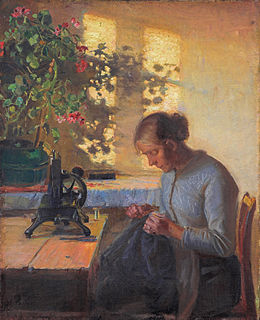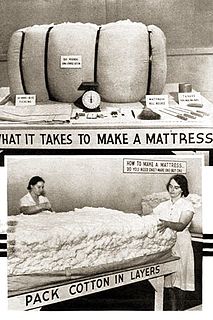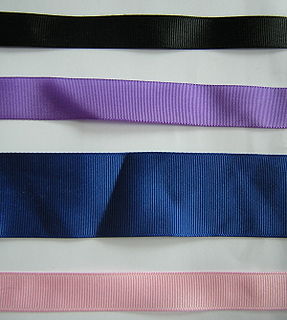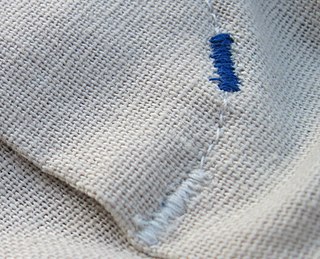Related Research Articles

Sewing is the craft of fastening or attaching objects using stitches made with a needle and thread. Sewing is one of the oldest of the textile arts, arising in the Paleolithic era. Before the invention of spinning yarn or weaving fabric, archaeologists believe Stone Age people across Europe and Asia sewed fur and skin clothing using bone, antler or ivory needles and "thread" made of various animal body parts including sinew, catgut, and veins.

A safari jacket or bush jacket is a garment originally designed for the purpose of going on safari in the African bush. When paired with trousers or shorts, it becomes a safari suit. A safari jacket is commonly a lightweight cotton drill or lighter poplin jacket, traditionally khaki in color, with a self-belt, epaulets, four or more expandable bellows pockets and often with cartridge loops.

Interfacing is a textile used on the unseen or "wrong" side of fabrics to make an area of a garment more rigid.

A hem in sewing is a garment finishing method, where the edge of a piece of cloth is folded and sewn to prevent unravelling of the fabric and to adjust the length of the piece in garments, such as at the end of the sleeve or the bottom of the garment.

In sewing and fashion design, a pattern is the template from which the parts of a garment are traced onto fabric before being cut out and assembled. Patterns are usually made of paper, and are sometimes made of sturdier materials like paperboard or cardboard if they need to be more robust to withstand repeated use. The process of making or cutting patterns is sometimes condensed to the one-word Patternmaking, but it can also be written pattern(-)making or pattern cutting.

Ticking is a cotton or linen textile that is tightly woven for durability and to prevent down feathers from poking through the fabric, and used to cover mattresses and bed pillows. It commonly has a striped design, in muted colors such as brown, grey or blue, and occasionally red or yellow, against a plain, neutral background.

Buttonholes are reinforced holes in fabric that buttons pass through, allowing one piece of fabric to be secured to another. The raw edges of a buttonhole are usually finished with stitching. This may be done either by hand or by a sewing machine. Some forms of button, such as a frog, use a loop of cloth or rope instead of a buttonhole. Buttonholes can also refer to flowers worn in the lapel buttonhole of a coat or jacket, which are referred to simply as "buttonholes" or boutonnières.

A shank is a device for providing a small amount of space in between a garment and a button. Shanks are necessary to provide space for fabric to sit in between the button and the garment when the garment is buttoned. Shanks also allow a garment to hang and drape nicely.
Contrast fabric is a term used in sewing used to refer to a fabric piece or embellishment made from a different fabric than the main fabric. The term contrast fabric directly contrasts with the term self-fabric.

In sewing and crafts, an embellishment is anything that adds design interest to the piece.
Heirloom sewing is a collection of needlework techniques that arose in the last quarter of the 20th century that imitates fine French hand sewing of the period 1890-1920 using a sewing machine and manufactured trims.

Grosgrain, is a type of fabric or ribbon defined by the fact that its weft is heavier than its warp, creating prominent transverse ribs. It is called a "corded" fabric since the weft resembles a fine cord. Grosgrain is a plain weave corded fabric, with heavier cords than in poplin but lighter than in faille. Grosgrain has a very dull appearance with little luster but is very strong. It is a firm, close-woven, fine-corded fabric. Grosgrain fabric is most commonly available in black, but grosgrain ribbon comes in a large variety of colors and patterns. The ribbon is very similar to Petersham ribbon in its appearance, but it does not have the ability to follow the curves of a surface or edge the way that the latter does.

In sewing, bar tack, also written bar-tack or bartack, refers to a series of stitches used to reinforce areas of a garment that may be subject to stress or additional wear. Typical areas for bar tack stitches include pocket openings, buttonholes, belt loops, the bottom of a fly opening, tucks, pleats and the corners of collars. Bar tacks may be sewn by hand, using whip stitches, or by machine, using zigzag stitches. The process for sewing a bar tack is essentially to sew several long, narrowly-spaced stitches along the line of the bar that will be formed, followed by short stitches made perpendicular to the long stitches, through the fabric and over the bar. The bar commonly varies between 1⁄16 to 1⁄8 inch in width and 1⁄4 to 3⁄8 inch in length. In some garments, such as jeans, the bar tack will be sewn in a contrasting color.

In sewing, piping is a type of trim or embellishment consisting of a strip of folded fabric so as to form a "pipe" inserted into a seam to define the edges or style lines of a garment or other textile object. Usually the fabric strip is cut on the bias. It may be made from either self-fabric or contrasting fabric, or of leather.
Sewing is the craft of fastening or attaching objects using stitches made with needle and thread. Sewing is one of the oldest of the textile arts, arising in the Paleolithic Era. Although usually associated with clothing and household linens, sewing is used in a variety of crafts and industries, including shoemaking, upholstery, sailmaking, bookbinding and the manufacturing of some kinds of sporting goods. Sewing is the fundamental process underlying a variety of textile arts and crafts, including embroidery, tapestry, quilting, appliqué and patchwork.

In sewing, a seam is the join where two or more layers of fabric, leather, or other materials are held together with stitches. Prior to the invention of the sewing machine, all sewing was done by hand. Seams in modern mass-produced household textiles, sporting goods, and ready-to-wear clothing are sewn by computerized machines, while home shoemaking, dressmaking, quilting, crafts, haute couture and tailoring may use a combination of hand and machine sewing.

In sewing and tailoring, a lining is an inner layer of fabric, fur, or other material inserted into clothing, hats, luggage, curtains, handbags and similar items.

In sewing and tailoring, facing is a small piece of fabric, separate or a part of the fabric itself, used to finish the fabric edges. Facing makes a garment look professionally finished with the seams well hidden inside the folds of the facing. Facing is mostly used to finish the edges in necklines, armholes, hems and openings. They are also used widely in all other sewing like quilts and home decor items like curtain hems.

Petersham ribbon, also called Petersham facing or simply Petersham, is a thick, stiff, flexible corded ribbon usually made out of either cotton, rayon, viscose, or a cotton/ rayon or viscose blend of fibers and used as facing by milliners and tailors. Petersham is frequently watered on both sides and comes with a scalloped edge. It is woven so that once steamed, it will take on and support a particular curve of fabric. This makes it useful for obtaining a smooth edge on the brim of a hat, for example, without forming puckers or wrinkles which would result from the use of traditional flat ribbon or other flat fabric. It is also useful as an alternative to bias tape for making fabric conform closely to the shape of the body wearing it— in a corset, for example, or along the waistline of a pair of trousers or a skirt. Petersham is utilized in couture sewing as a form of interfacing as way to stabilize waistbands.

A pick stitch in sewing is a simple running stitch that catches only a few threads of the fabric, showing very little of the thread on the right side of the garment. It is also sometimes known as "stab stitch".
References
- ↑ Fasanella, Kathleen (25 August 2006). "What does "self" mean?". Fashion-Incubator. Retrieved 27 February 2019.
- ↑ Shaeffer, Claire B. (2011). Couture Sewing Techniques (Rev. and updated ed.). Taunton Press. pp. 143, 217–219. ISBN 1600853358.
- ↑ Czachor, Sharon L. (2016). "Closures: Buttonholes, Snaps, Covered Buttons, and Layered Buttons". Sewing with Knits & Stretch Fabrics. Bloomsbury Publishing Inc. p. 167. ISBN 1628921811.
- ↑ Shaeffer, Claire B. (2011). Couture Sewing Techniques (Rev. and updated ed.). Taunton Press. pp. 91–92. ISBN 1600853358.
| | This textile arts article is a stub. You can help Wikipedia by expanding it. |